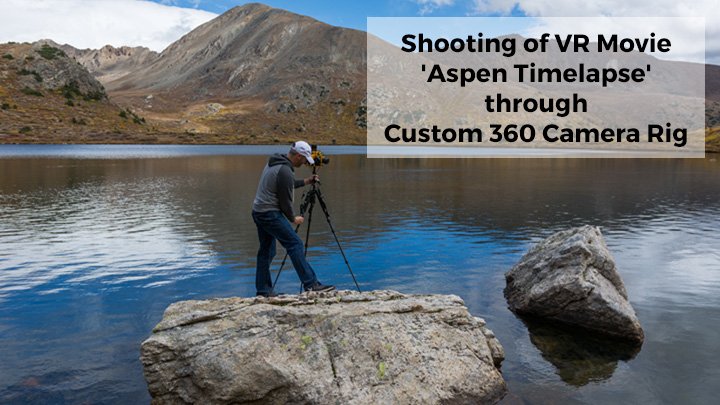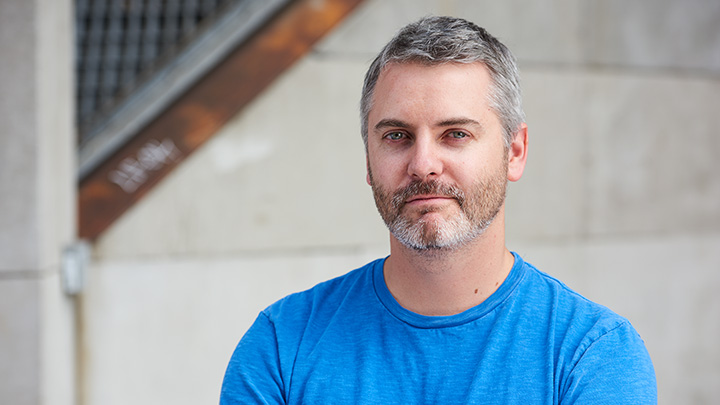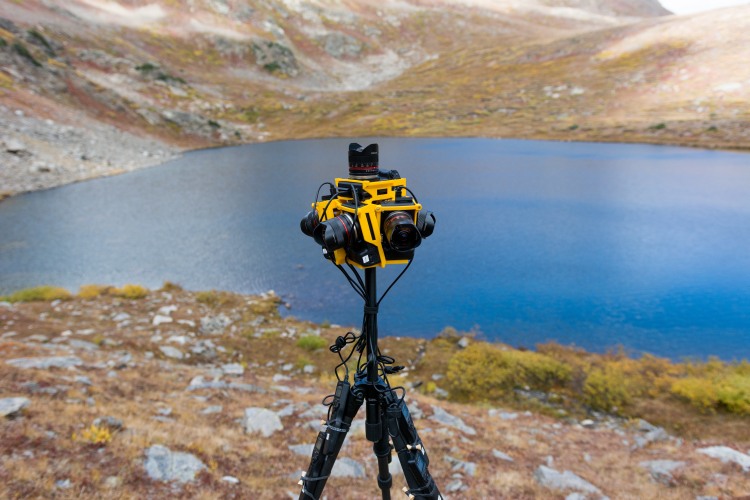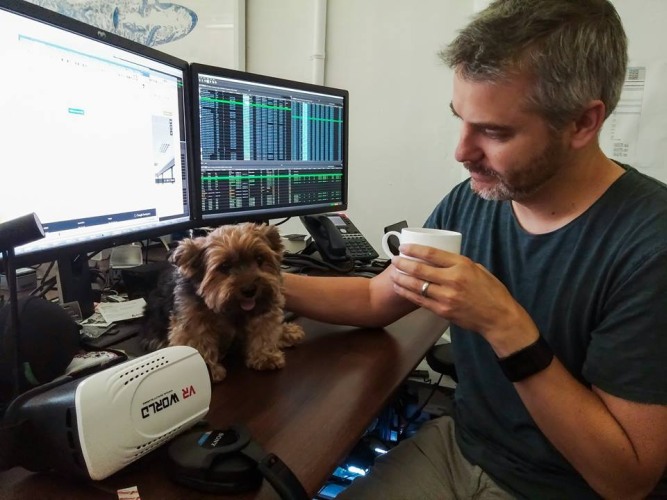We talked to Sam O’Hare about the custom 360 camera rig he built and the ethereal VR timelapse landscapes in Aspen he shot with it, along with his views about VR and its future.
Sam O’Hare is a founder of NYC based VFX studio Parachute and also directs through Rocket Film. He has a background in still photography, live action directing, visual effects and architecture. He’s interested in creating imagery (of all types) and the source of that imagery can vary greatly depending upon the needs of the project. In his mind, there are no walls and no boundaries, or, if there are, you can just pick them up and move them somewhere else.
Hi Sam. Let our readers know about your technical background.
I studied architecture in the UK and during my time there, I taught myself computer graphics. I then worked in architectural visualization for 6 years and after moving to the US started doing VFX for commercials. After a further 3 years, I started directing too. I now work in most areas of generating and manipulating imagery, be it live action or post, including 3D, compositing, colour correction, etc. I am also interested in emerging technologies and cameras in particular.
Why did you choose VFX field as your career?
Back in architecture school when I first used 3D software, I was hooked. It felt like grown-up Lego, and I loved that freedom of being able to create images and video out of nothing.
Kindly share the journey of establishing ‘Parachute’.
Once I started directing, I was working with other companies to complete the visual effects on my commercials, but even working with great teams, that wasn’t ideal for me. I’ve always approached my work by thinking what the best tool is for any given shot, be it live action, CGI or a mix of both. I missed being able to use the tools directly to that end and we set up Parachute to allow that holistic approach, not just for myself but for the other directors too.
What are Parachute’s remarkable credentials till date?
We’ve worked on projects from a variety of clients, including Chrysler, The US Navy, CNN, Direct TV, Syfy, Jose Cuervo, Wells Fargo, ESPN and Milk.
- Our film The Sandpit won a Prix Ars Electronica Award of Distinction, and screened at AFI Fest and Tiburon Film Festival. It was also nominated for 2 Webby’s, best viral and best music, and resides in MoMA’s permanent collection.
- Our Tesla – Fireflies spot was featured in Adweek, AdAge and listed as one of the top 5 ads of the week by Fast Company in 2015, and also written up by Chaos Group who built the rendering software we used.
Rocket Film seems unique. How did it happen and you become part of it?
Rocket grew out of a wish for a more collaborative and empowering kind of production company. We feel like everyone does their best work when the creative is supported and directors have communication and insight into their colleague’s work. I’ve often collaborated with other directors when they have worked on VFX heavy spots, so this model is ideal for me. I get to work with exceptionally talented people who are also helpful and great to sit down and share ideas with.
What led you to create the custom 360 camera rig?
I was interested in creating immersive 360 video, and was looking at the rigs that were available to do it. At the time, there weren’t any that gave me the manual control I wanted, and were small and portable enough to use easily. I performed some tests with some rigs and wasn’t pleased with the results. Even looking at some of the more expensive integrated solutions, the quality of the footage was lacking. I decided to design mine around the Sony A6300, a crop sensor mirrorless camera that has manual controls, a high quality sensor and shoots 4K video, but was only slightly larger than a GoPro.
Do share the challenges you overcame to achieve this Aspen VR project.
The first challenge was to design and build the rig. I started by doing photogrammetry of the camera itself, to generate a 3D model of it. I then built a support for that in 3dsmax, printed it, and used it to make measurements by rotating the rig on a tripod and taking pictures at each location a camera would be at to ensure that I would be able to stitch the footage. That test was successful, so I then spent some time designing and refining the rig in 3D to fit all six cameras tightly, cover the whole sphere of view, minimise distance between the lenses to reduce parallax, and ensure that the controls and card and battery slots on the camera could be accessed. I then refined it further to print cleanly in 2 pieces that required no support on our 3D printer. This is important as with a complex mesh like this, removing internal supports can be hard work, leave rough edges, and wastes filament. It was also designed with an open core to dissipate heat cleanly, as overheating can be a problem when shooting video.
On set, it was mostly about getting to the locations we wanted to shoot. We had to climb mountains and descend down steep wooded slopes. We set the cameras up late at night in the dark, and fetched them early in the morning sometimes before sunrise. We waded into freezing cold mud at 6am, and through dense woodland in the pitch dark. Walking back up a hill from one shot in a lake before dawn, after disconnecting the USB cables for the intervalometers, I swung the rig over a bush and the tip of a USB cable whipped through my right eye and sliced a chunk out of my cornea. That made the rest of the shoot challenging because I couldn’t see any details with that eye.
For the overnight shots, we needed to power the cameras externally as the internal batteries wouldn’t last long enough. We brought a large external battery – basically a car battery with power and USB ports, and connected the cameras to it via a power strip. For the overnight lake shot, my colleague Klaus put the whole contraption into a dry bag, hung it from the bottom of the tripod and propped on top of a small log. It looked wobbly, but it worked!
Check out the complete VR movie using custom 360 camera rig.
Share your views about current and future applications of VR.
Virtual Reality (VR) as a medium has huge potential. It’s already been shown to be popular in games and education particularly. Being able to watch how a surgeon and their team perform a complex procedure while standing right with them, for example, is very powerful. 360 video can allow you to experience a space in a new and interesting way, and it’s also great for documentary work where you can feel really immersed in the environment.
It is also moving forward technically, with 6DOF video coming soon that will untether your head so you can actually move around the recorded space a little, and gaining benefit from the parallax which is currently problematic. The current set of head mounted displays are also a little limiting, but future revisions will increase field of view, resolution and comfort, and make the experience better all around.
What do you think; can too much VR harm the storytelling?
For narrative it’s definitely much more challenging. Storytelling is about showing the audience exactly what you want them to see, to push the story forward. With 360 video, you can attract people’s attention to specific parts of the space with audio or visual cues, but there’s no way they can see everything happening in a scene, so it’s trickier. It works much better with slower cuts, and a more experiential feel.
What are your future goals?
I enjoy working with imagery and technology in general. I’m always interested in playing around with how these things intersect, and how computational photography can create new ways of seeing the world. It’s interesting to see how these can apply to the communication of ideas and film making going forward. Often advertising is on the forefront of adopting these kind of technologies and it’s always exciting to see how they can interface with brands and help communicate their stories.
Following from that, I’m also interested in how how technology and humanity interact, and the changing nature of our lives in a time of such accelerating invention and change. Each new technology is an opens the door to a new story, and I hope to tell some of those.




